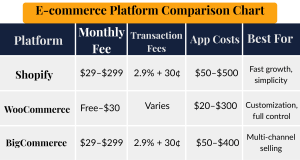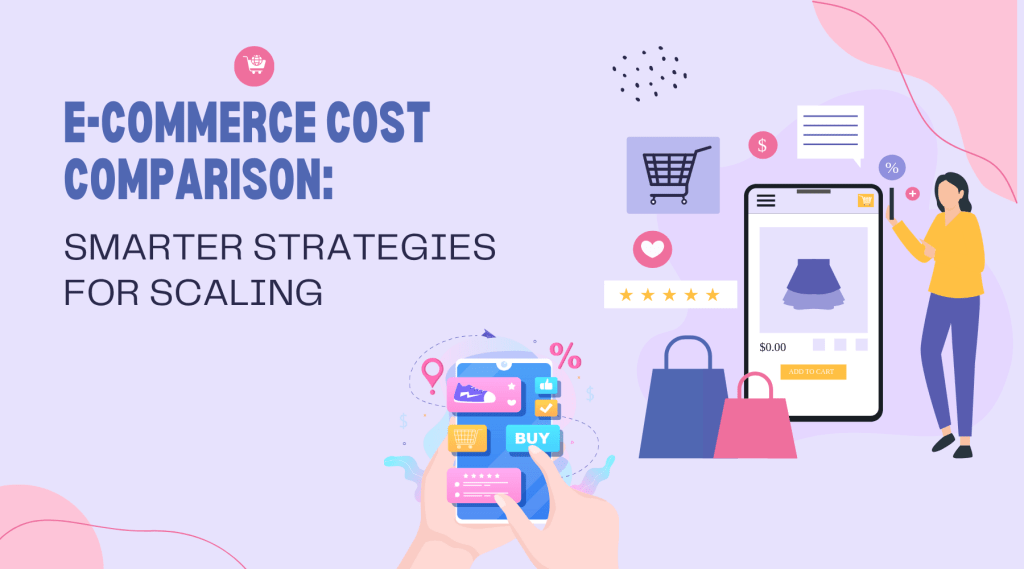Introduction
Scaling your e-commerce brand? Then you know every dollar needs to work overtime. Even seasoned entrepreneurs often ask: Where is my money going, and is it delivering ROI?
A clear cost breakdown is more than budgeting, it’s a roadmap for sustainable growth. From platform fees and payment processing to ad spend and fulfillment, knowing your numbers puts you in control.
In this post, we’ll unpack the true costs behind a growing e-commerce business and share advanced strategies to cut waste, boost ROI, and scale with confidence.
TL;DR:
This guide reveals a practical, data-driven e-commerce cost breakdown with expert strategies to reduce spend, increase conversions, and grow a brand that lasts.
Why Cost Comparison Is Non-Negotiable When Scaling
Take Sophia Martinez, for example, an established founder running a niche brand on Shopify, active across Google Ads, Instagram, Pinterest, and SEO. Her brand is pulling in over $500K a year. But with higher revenue comes greater complexity: more tools, larger campaigns, and rising costs.
Whether you’re launching new SKUs, entering international markets, or planning for peak season, expenses can snowball. And without a clear cost comparison? You risk burning your budget instead of building momentum.
Bottom line: Knowing where your dollars go lets you reinvest smarter, in your products, your people, and your future.
Core E-commerce Costs That Affect Your Profit Margins
1. Platform Fees
Examples: Shopify, WooCommerce, BigCommerce
Monthly plans: $29–$299 (Shopify), with higher tiers for high-volume brands
Transaction fees: 2.9% + 30¢ (unless using Shopify Payments)
Apps & plugins: $50–$500/month, depending on features
Pro Tip:
Audit your tech stack quarterly. You might be paying for apps you no longer use, or ones that can be consolidated.
2. Payment Processing Fees
Examples: Stripe, PayPal, Square
Domestic: 2.9% + 30¢ per transaction
International: Add 1–2% extra
Chargebacks: Typically $15–$25
PPC Tip:
If you’re advertising internationally, offering local payment methods can reduce abandoned carts.
3. Website Development & Maintenance
Initial setup: $2,000–$10,000+
Monthly maintenance: $100–$500
Annual UX/design updates: $2,000–$5,000
Best Tools: Hotjar, Google Optimize, SEMrush
4. Product Sourcing & Inventory
Annual inventory costs: $10,000–$50,000+
Warehousing: $1–$2 per cubic foot/month
Inventory management software: $50–$300/month
Scaling Strategy:
Use forecasting tools and negotiate bulk pricing to avoid overstocking and underperformance.
5. Shipping & Fulfillment
Carrier rates: Depend on weight, speed, and zones
Custom packaging: $1–$5 per order
Returns: Expect 5–10% of orders
3PL services: $2–$5 per order
Quick Win:
Test free shipping thresholds to increase average order value (AOV) without tanking margins.
6. Marketing & Advertising
Google Ads (Search, Shopping, Display):
Management fees: $1,000–$5,000/month
Ad spend: $5,000–$50,000+/month
Average CPC: $0.50–$3+
Tips:
Focus on high-intent, long-tail keywords
Use negative keywords to block irrelevant traffic
Schedule ads during peak buying hours
Meta Ads (Facebook/Instagram):
Ad spend: $2,000–$20,000+/month
CPM range: $5–$15
Tools: Facebook Ads Manager, Revealbot
Content Marketing & SEO:
Blog/video content: $200–$1,000 per asset
SEO tools: $100–$400/month
Influencer campaigns: $500–$5,000+
Pro Tip:
Content and reputation marketing create visibility during slower sales cycles and build long-term brand equity.
7. Customer Service & Retention
Live chat/helpdesk: $50–$300/month
Self-service portals: $500–$2,000 setup
Outsourced support: $1–$2 per ticket
Advanced Strategy:
Connect support data with ad platforms and email tools for personalized customer retention campaigns.

Tip for Global Growth:
Choose a platform with built-in localization tools (currencies, language, tax settings) to avoid expensive workarounds.
Advanced Cost Optimization Strategies for Scale-Ready Brands
Tool Consolidation: Audit your stack for overlaps and cut what you don’t use.
Automated Dashboards: Track key ROI metrics in real time.
Vendor Negotiation: High-volume brands have more leverage than you think—use it.
Smart Outsourcing: Bring in specialists for PPC, SEO, or design only when needed.
Expanding Globally? Here’s How to Keep Costs in Check
Localize everything: Pricing, copy, checkout, and support
Understand duties: Research VAT, GST, and import fees
Start small: Run micro-campaigns with Google or Meta to test new markets before committing
Must-Have Tools for Scaling E-commerce Operations
Google Analytics + Data Studio – Custom dashboards for performance visibility
SEMrush / Ahrefs – SEO, keyword, and competitive insights
Revealbot / AdEspresso – Automation for ads and split testing
Klaviyo / Omnisend – Email automation tailored to customer behavior
Final Thoughts: Make Every Dollar a Growth Driver
Scaling your e-commerce brand isn’t just about revenue—it’s about clarity, strategy, and smart reinvestment. With a detailed cost comparison and a few high-leverage tweaks, you can scale without burning out or bleeding budget.
Want expert eyes on your ad strategy or tech stack?
👉 Book a free strategy call or download our PPC Performance Checklist to start scaling smarter today.

